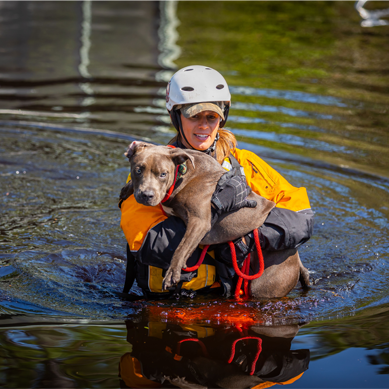
PLAN AT HOME
When disaster strikes, it is important to be prepared. Here are some things you can do to make sure you and your pets are ready for anything.
PLAN AT HOME
When disaster strikes, it is important to be prepared. Here are some things you can do to make sure you and your pets are ready for anything.
Your pets are an important member of your family, so they need to be included in your family’s emergency plan.
To prepare for the unexpected follow these tips with your pets in mind:
- Secure a carrier for each of your animals.
- Take quality frontal and profile photographs of each of your animals. Have numerous copies of each made. If an animal has an individual or identifying mark, take a photograph and keep it with you. Use this as positive ID if you need to reclaim your pet.
- Make a copy of each animal’s medical records, especially of health and current rabies certificates. Some kennels, clinics, etc. now require proof of kennel cough inoculations.
- Have a special collar name tag made with multiple contact numbers and addresses.
- Familiarize your pets with their carriers by loading them into the cages. Use food as an enticement if necessary. When an emergency comes, you want the animal to enter willingly and without delay.
- Contact out-of-area clinics, boarding kennels, and motels to check on rules and accommodations.
- Consider special needs for evacuating livestock and ensure that horses will easily load into trailers.
- Have your animals micro-chipped or tattooed.
- Plan with neighbors, friends or relatives to make sure that someone is available to care for or evacuate your pets if you are unable to do so. Give them written permission for a vet to treat your animals.
- Let emergency responders know that there are pets in the house by placing signs or window stickers at or near all entrances to your house indicating that there are pets inside.
- Make up your disaster kit including:
- water and food for seven days,
- water and food bowls,
- leashes and ID collars,
- First Aid kit,
- medications,
- medical records,
- familiar toys,
- muzzle,
- cleaning supplies,
- contact card
- Designate a family member to be in charge of animals. Have them practice an emergency drill.
- Make sure collars fit the animal. Consider breakaway collars for cats.
- A picture of you and your pet together. If you become separated from your pet during an emergency, a picture of you and your pet together will help you document ownership and allow others to assist you in identifying your pet.
- Confine outside animals in an accessible safe area
- Confine all animals for transport
- Load disaster kit, emergency gear and animals
- Turn off electricity, water main, and/or gas
- Lock up and get out
- If it is physically impractical to take your pets with you, do your best to:
- Leave plenty of food and water
- Leave animals in a safe room, preferably upstairs if flooding is an issue
- Remove breakables
- Separate dogs and cats
- Never leash or chain an animal
- Post reliable contact information (cell phone & out of area friend or relative) visible to potential responders
- Scent posts and landmarks have changed. Keep your pet leashed until it has re-acclimated.
- Wild animals will be displaced. Beware of snakes, raccoons, etc.
- Be mindful of downed power lines and environmental hazards.
- Be very careful when approaching strange animals. Even the friendly dog next door may be aggressive due to trauma, injury, a change in territorial boundaries, etc.
- If you encounter a dead companion animal, help the owner by taking pictures, documenting ID and/or collar and noting any marks or tattoos. Take the information to your sheltering facility.
- Standing water will produce increased generations of fleas, mosquitoes, ticks, heartworms and intestinal parasites. Increased vet care is advised.
Your pets are an important member of your family, so they need to be included in your family’s emergency plan.
To prepare for the unexpected follow these tips with your pets in mind:
- Secure a carrier for each of your animals.
- Take quality frontal and profile photographs of each of your animals. Have numerous copies of each made. If an animal has an individual or identifying mark, take a photograph and keep it with you. Use this as positive ID if you need to reclaim your pet.
- Make a copy of each animal’s medical records, especially of health and current rabies certificates. Some kennels, clinics, etc. now require proof of kennel cough inoculations.
- Have a special collar name tag made with multiple contact numbers and addresses.
- Familiarize your pets with their carriers by loading them into the cages. Use food as an enticement if necessary. When an emergency comes, you want the animal to enter willingly and without delay.
- Contact out-of-area clinics, boarding kennels, and motels to check on rules and accommodations.
- Consider special needs for evacuating livestock and ensure that horses will easily load into trailers.
- Have your animals micro-chipped or tattooed.
- Let emergency responders know that there are pets in the house by placing signs or window stickers at or near all entrances to your house indicating that there are pets inside.
- Make up your disaster kit including water and food for seven days, water and food bowls, leashes and ID collars, First Aid kit, medications, medical records, familiar toys, muzzle, cleaning supplies and a contact card.
- Designate a family member to be in charge of animals. Have them practice an emergency drill.
- Formulate a buddy system with a neighbor or friend who can check and care for your pets if you are out of the area and cannot return. Give them written permission for a vet to treat your animals.
- Make sure collars fit the animal. Consider breakaway collars for cats.
- Confine outside animals in an accessible safe area
- Confine all animals for transport
- Load stored emergency gear and animals
- Turn off electricity, water main, and/or gas
- Lock up and get out
- Scent posts and landmarks have changed. Keep your pet leashed until it has re-acclimated.
- Wild animals will be displaced. Beware of snakes, raccoons, etc.
- Be mindful of downed power lines and environmental hazards.
- Be very careful when approaching strange animals. Even the friendly dog next door may be aggressive due to trauma, injury, a change in territorial boundaries, etc.
- If you encounter a dead companion animal, help the owner by taking pictures, documenting ID and/or collar and noting any marks or tattoos. Take the information to your sheltering facility.
- Standing water will produce increased generations of fleas, mosquitoes, ticks, heartworms and intestinal parasites. Increased vet care is advised.


